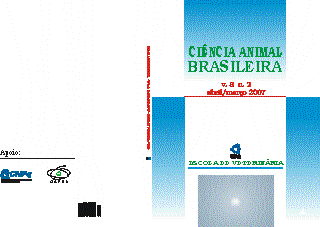ANTHELMINTIC RESISTANCE ON SHEEP FLOCKS FROM ASSOCIATION OF THE MUNICIPALITIES OF THE ALTO IRANI REGION (AMAI), WEST OF SANTA CATARINA STATE, BRAZIL
Keywords:
Parasitos, resistência a drogas, OvinosAbstract
In order to know the situation of the anthelmintic resistance in sheep farms in the municipalities of Asso-ciation of the municipalities of the High Irani Region - AMAI, West of Santa Catarina State, Brazil, nine flocks were submitted to the faecal egg counts reduction test (FECRT). This test consists in comparing the mean FEC of a group of sheep, 14 days after treatment with the mean FEC of a non-treated control group. Only drugs that could reduce FEC up to 95% were considered effective. The mo-lecules used were: levamisole (7.5 mg/kg), closantel (7.5 mg/Kg), albendazole (10 and 5 mg/Kg), ivermectin and moxidectin (0.2 mg/Kg). It was detected resistance of the gastrointestinal nematodes to all the anthelmintics tested. One hundred percent of the farms showed resistance to the ivermectin, 66.7% to the moxidectin, 44.4% to levamisole e 75% to albendazole. To the macrocyclic lactones and al-bendazol, both Haemonchus sp. and Trichostrongylus sp. were resistant. To levamisole, resistance is restricted to the genus Trichostrongylus. It was also detected one population of Haemonchus sp. resistant to Closantel and one of Nematodirus sp. resistant to albendazole. These data show the urgency to spread means of integrated control of para-sites, with the objective to enlarge the life of the few drugs that remain effective.
KEY-WORDS: Anthelmintic resistance, Santa Catarina, SHEEP.
Downloads
Downloads
Published
How to Cite
Issue
Section
License
Copyright (c) 2007 Brazilian Animal Science/ Ciência Animal Brasileira

This work is licensed under a Creative Commons Attribution 4.0 International License.
Authors who publish with this journal agree to the following terms:
- Authors retain copyright and grant the journal right of first publication with the work simultaneously licensed under a Creative Commons Attribution License that allows others to share the work with an acknowledgement of the work's authorship and initial publication in this journal.
- Authors are able to enter into separate, additional contractual arrangements for the non-exclusive distribution of the journal's published version of the work (e.g., post it to an institutional repository or publish it in a book), with an acknowledgement of its initial publication in this journal.
- Authors are permitted and encouraged to post their work online (e.g. in institutional repositories or on their website) prior to and during the submission process, as it can lead to productive exchanges, as well as earlier and greater citation of published work (See The Effect of Open Access).




























